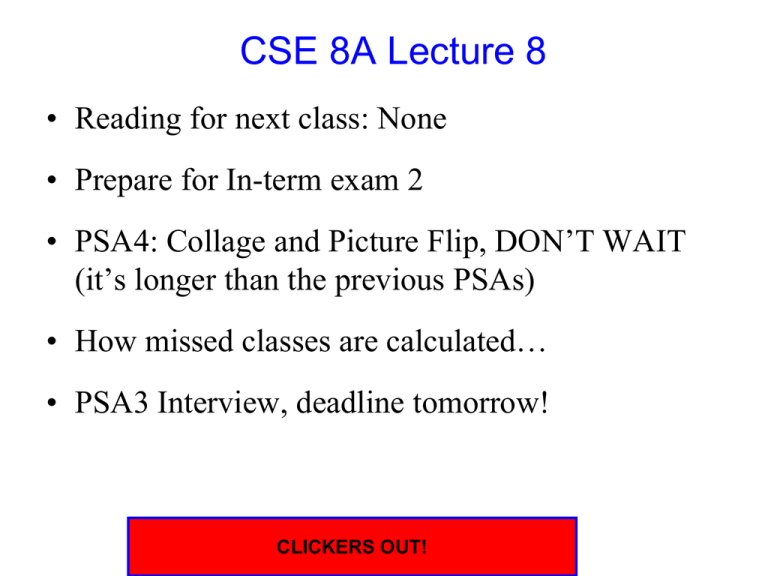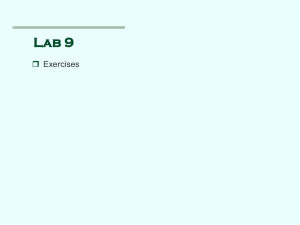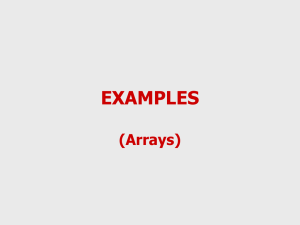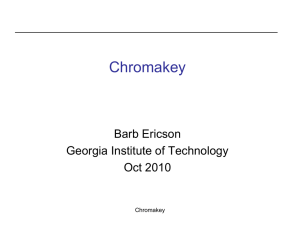CSE8A: Introduction to Programming in Java
advertisement

CSE 8A Lecture 8
• Reading for next class: None
• Prepare for In-term exam 2
• PSA4: Collage and Picture Flip, DON’T WAIT
(it’s longer than the previous PSAs)
• How missed classes are calculated…
• PSA3 Interview, deadline tomorrow!
CLICKERS OUT!
1. If this is the header to a function defined in
Picture.java:
public Picture scaleUp(int numTimes)
{
....
}
What should the method call look like if I call it on a
Picture object named pictObj and I wanted to use
the Picture object that it returns?
A. Picture pictReturned = scaleUp(2);
B. Picture pictReturned = pictObj.scaleUp(2);
C. String pictReturned = pictObj.scaleUp(2);
D. Picture = pictObj.scaleUp(2);
READING QUIZ – NO TALKING – CORRECTNESS MATTERS
2.To scale a picture smaller by 2 (to make a copy of the picture that is half the
size of the source) what should go in the blanks
public void copySmaller()
{
Picture pictObj = new Picture(FileChooser.pickAFile());
Pixel sourcePixel = null;
Pixel targetPixel = null;
//loop through the columns
for(int sourceX=0, targetX=0;
sourceX < pictObj.getWidth();
____1_____, targetX++)
{
//loop through the rows
for(int sourceY=0; targetY=0;
soruceY < pictObj.getHeight();
____2____, targetY++)
{
sourcePixel = pictObj.getPixel(sourceX, sourceY);
targetPixel = this.getPixel(targetX,targetY);
targetPixel.setColor(sourcePixel.getColor());
}
}
}
A. 1. sourceX++
2. sourceY+=2
B. 1. sourceX+=2
2. sourceY+=2
C. 1. sourceX+=2
2. sourceY++
D. 1. sourceX++
2. sourceY++
READING QUIZ – NO TALKING – CORRECTNESS MATTERS
3. How do I blend two picture objects
with 50% of one picture and 50% of
another picture?
A. By multiplying their colors together and by 0.5
B. By adding them together
C. By multiplying their colors by 0.5 and then adding
them
READING QUIZ – NO TALKING – CORRECTNESS MATTERS
4. Imagine that you have a method copyPictureTo, whose header is below, defined in
Picture.java. This method copies the source Picture (sourcePic) and places its top left
corner at (xStart, yStart) of the Picture that called the copyPictureTo method.
public void copyPictureTo(Picture sourcePic, int xStart, int yStart)
Assume you have already created two Picture objects: sourcePic and pictObj, and
you make the following call:
pictObj.copyPictureTo(sourcePict, pictObj.getWidth()/2, 0);
Which position below best represents where the sourcePic will be located in picObj
after the call? Assume that sourcePic is much smaller than pictObj.
A
B
C
D
Arrows indicate
half the target
picture width and height
picObj
READING QUIZ – NO TALKING – CORRECTNESS MATTERS
Mirroring Even Width versus Odd Width
int mirrorPt = getWidth() / 2;
...
for (int x = 0; x < mirrorPt; x++)
1) Solo: (30 sec)
2) Discuss: (2min)
3) Group: (30 sec)
Mirroring Odd-width Pictures
• What happens when this code attempts to mirror a Picture around the vertical
axis when the Picture’s width is odd (e.g. 101)?
int mirrorPt = getWidth()/2;
Pixel leftP, rightP;
for (int y = 0; y < getHeight(); y++)
{
for (int x = 0; x < mirrorPt; x++)
{
leftP = getPixel(x,y);
rightP = getPixel(getWidth()-1-x,y);
rightP.setColor(leftP.getColor());
}
}
A. It will work fine
B. It will run, but it won’t
mirror correctly
C. I won’t run, there will
be an index out of
bounds exception
D. It won’t even compile
if getWidth() is odd
1) Solo: (30 sec)
2) Discuss: (2min)
3) Group: (30 sec)
Mirroring Odd-width Pictures
• What happens when this code attempts to mirror a Picture around the vertical
axis when the Picture’s width is odd (e.g. 101)?
int mirrorPt = getWidth()/2;
Pixel leftP, rightP;
for (int y = 0; y < getHeight(); y++)
{
for (int x = 0; x < mirrorPt; x++)
{
leftP = getPixel(x,y);
rightP = getPixel(getWidth()-1-x,y);
rightP.setColor(leftP.getColor());
}
}
A. It will work fine
B. It will run, but it won’t
mirror correctly
C. I won’t run, there will
be an index out of
bounds exception
D. It won’t even compile
if getWidth() is odd
1) Solo: (30 sec)
2) Discuss (1 min)
3) Group
What are the first (x,y) coords for
topP and bottomP
to mirror around horizontal axis?
topP
bottomP
A. (0,0)
(0,1)
(1,0)
(0,3)
(0,2)
(1,3)
B. (0,0)
(1,0)
(2,0)
(0,3)
(1,3)
(2,3)
C. either A or B will work
D. none of the above
Challenge: Complete the code that mirrors in
the order specified by answer B
topP
B. (0,0)
(1,0)
(2,0)
bottomP
(0,3)
(1,3)
(2,3)
int height = getHeight();
int width = getWidth();
int mid = height/2;
Pixel topP, botP;
for (
for(
topP = getPixel(
botP = getPixel(
botP.setColor(topP.getColor());
}
}
){
) {
);
);
Order of copying pixels
• When mirroring, we need to copy certain pixels to
certain other pixels
• It doesn’t matter what order we copy in, as long as
when we are done, pixels have been copied correctly
• Two most common orders:
• Row major order: copy all the pixels in one row, then go on
to the next row
• Column major order: copy all the pixels in one column,
then go on to the next column
Mirroring around horizontal axis
column-major order
int height = getHeight();
int width = getWidth();
int mid = height/2;
Pixel topP, botP;
for(int x=0; x<width; x++) {
for(int y=0; y<mid; y++) {
topP = getPixel(x,y);
botP = getPixel(x,height-1-y);
// copy one to the other…
}
}
topP
A. (0,0)
(0,1)
(1,0)
…
botP
(0,3)
(0,2)
(1,3)
…
row-major order
int height = getHeight();
int width = getWidth();
int mid = height/2;
Pixel topP, botP;
for(int y=0; y<mid; y++) {
for(int x=0; x<width; x++) {
topP = getPixel(x,y);
botP = getPixel(x,height-1-y);
// copy one to the other…
}
}
topP
B. (0,0)
(1,0)
(2,0)
…
botP
(0,3)
(1,3)
(2,3)
…
1) Solo: (1 min)
2) Discuss: (2 min)
3) Group: (30 sec)
Challenge: What does
this code do?
• Hint: trace some of the getPixel index values.
int magic = getWidth()/2;
Pixel foo, bar;
for(int y = 0; y < getHeight(); y++)
{
int countingDown = getWidth()-1;
for(int x = 0; x < magic; x++)
{
foo = getPixel(x,y);
bar = getPixel(countingDown,y);
bar.setColor(foo.getColor());
countingDown--;
}
}
A. Copies top half into
bottom half not
mirrored.
B. Copies left half into
right half not
mirrored.
C. Mirrors around
vertical axis, left into
right
D. Mirrors around
horizontal axis, top
into bottom
E. Some other bizarre
transformation
1) Solo: (1 min)
2) Discuss: (2 min)
3) Group: (30 sec)
Challenge: What does
this code do?
• Hint: trace some of the getPixel index values.
foo
int magic = getWidth()/2;
Pixel foo, bar;
for(int y = 0; y < getHeight(); y++)
{
int countingDown = getWidth()-1;
for(int x = 0; x < magic; x++)
{
foo = getPixel(x,y);
x
bar = getPixel(countingDown,y);
bar.setColor(foo.getColor());
y
countingDown--;
}
}
countingDown
bar
By what variable name do we refer to
collage inside makeC in Picture.java?
public class Lab4
{
public static void main(String[] args)
{
Picture collage = new Picture("blank.jpg");
Picture p = new Picture("bird1.jpg");
Picture q = new Picture("bird2.jpg");
collage.makeC(p,q);
}
}
public class Picture
{
public void makeC(Picture p1, Picture p2)
{
Pixel[] targetPixels = _______.getPixels();
// … more code
}
}
A.
B.
C.
D.
E.
collage
callingObject
Object
Picture
this
Match the scenario
to the constructor call
(we’ll vote for each scenario)
Scenario
1) Create a picture from a
specific file
2) Create a picture that is a
copy of another picture
3) Create a picture of a given
width and height
4) Create a picture of the
same width and height as
another picture
Call
A.
Picture p =
new Picture();
B.
Picture p =
new Picture("filename.jpg");
C.
Picture p =
new Picture(other);
D.
Picture p =
new Picture(aNum,bNum);
1) Solo: (1 min)
2) Discuss: (2 min)
3) Group: (30 sec)
Pixel foo;
for(int y = 40; y < 50; y++)
{
for(int x = 1 ; x < 5; x++)
{
foo = getPixel(x,y);
foo.setColor(Color.RED);
}
}
What does
this code do?
Makes red box of
width height
1) Solo: (1 min)
2) Discuss: (2 min)
3) Group: (30 sec)
Pixel foo;
for(int y = 40; y < 50; y++)
{
for(int x = 1 ; x <= 5; x++)
{
foo = getPixel(x,y);
foo.setColor(Color.RED);
}
}
What does
this code do?
Makes red box of
width height
1) Solo: (1 min)
2) Discuss: (2 min)
3) Group: (30 sec)
What are correct loops
to make a black box of
width x and height y?
public void foo(int x, int y) {
Pixel foo;
<<<<LOOP HEADER 1>>>>
{
<<<<LOOP HEADER 2>>>>
{
foo = getPixel(w,h);
foo.setColor(Color.BLACK);
}
}
}
A) for (int w = 0; w <= x; w++)
for (int h = 0; h <= y; h++)
B) for (int w = 10; w < x+10; w++)
for (int h = 20; h < y+20; h++)
C) for (int w = 0; w < y; w++)
for (int h = 0; h < x; h++)
D) for(int w = 10; w <= x+10; w++)
for(int h = 20; h <= y+20; h++)
From the book: Cropping A Picture
(page 147-148) – we’ll change a bit
• Example of:
– Working with both the calling object and a parameter
object in a method
• Extra information is passed to methods through
parameters. The calling object is something like an extra
parameter, named this
– Doing something to a subset of the possible pixels in a
picture
1) Solo: (1 min)
2) Discuss: (2 min)
3) Group: (30 sec)
What part of Katie are we copying?(slight
mod from the book)
public void copyKatiesXXX(Picture sourcePic)
{
Pixel sPixel = null, tPixel = null;
for (int sX = 40, tX = 100; sX < 110; sX++, tX++)
{
for (int sY = 350, tY = 100; sY < 400; sy++, tY++)
{
sPixel = sourcePic.getPixel(sX,sY);
tPixel = this.getPixel(tX,tY);
tPixel.setColor(sPixel.getColor();
}
}
}
A. Feet
B. Part of dress
C. Hands
D. Part of Couch
E. Face
Parameters: getting information in to
methods
• It’s nice to have code that is “user controllable”…
• We have been hard-coding constants (40, 3, 100,
for example) a lot, but we can write more flexible
code using PARAMETERS
• This lets us write code to do things like “cropping
and pasting into a blank canvas”, but letting the
user specify what part of the source picture to crop,
and where to place it in the canvas.
Underline the values you would change into
parameters and write a new method header
public void copyKatiesXXX(
)
{
Pixel sPixel, tPixel = null;
for (int sX = 40, tX = 100; sX < 110; sX++, tX++)
{
for (int sY = 350, tY = 100; sY < 400; sy++, tY++)
{
sPixel = sourcePic.getPixel(sX,sY);
tPixel = this.getPixel(tX,tY);
tPixel.setColor(sPixel.getColor();
}
}
}
TODO
• Study for In-term Exam 2
• Start PSA4: Collage and Picture Flip
• Don’t forget your PSA3 interview!










